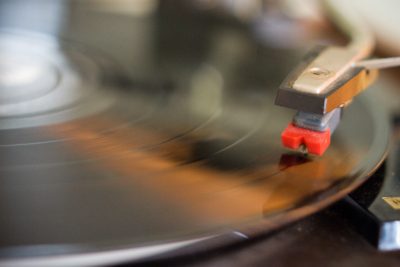12 Hours Inside The Brooklyn Rock Lottery
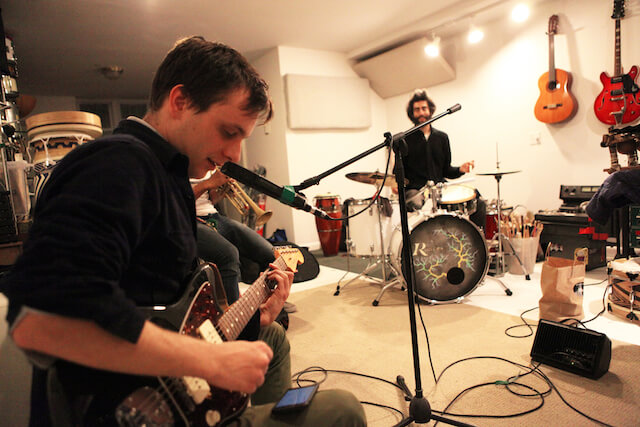

(All Photos by Kenneth Bachor)
The premise of the Brooklyn Rock Lottery could be a tagline for a mid-aughts MTV reality show: 25 strangers, grouped into bands at random, have 12 hours to put together a set to play in front of an audience. The Lottery’s organizer, Tierney Stout, inspired by a similar event in Denton, Texas, started putting on the show in 2009. All the musicians are volunteers (proceeds from the event this year went to Harmony Program, a nonprofit dedicated, in part, to introducing music programs to low-income students) and most of them are strangers to each other. This year marked the fifth annual Brooklyn Rock Lottery, and its first time to sell-out entirely. So in order to figure out how the whole thing works–would there be squabbles or long introspective conversations about cymbals? How do you start putting together a set of songs with strangers, anyway–I decided to follow around one group all day, from the lottery at 10 a.m. to the show twelve hours later.
9:47 am, Saturday, December 6
I arrived, bleary-eyed to Williamsburg’s Baby’s All Right to find a small but growing crowd of equally bleary-eyed musicians picking through bagels and pouring coffee into styrofoam cups. Instruments are piled in the corners of the little cafe area. Milling about already are a couple familiar faces: Drew Citron from Beverly, Sean Yeaton from Parquet Courts, Olly Peacock from Gomez. It’s a rainy, grey day out, and everyone seems like they’re still waking up. “Did you do anything to prepare for this?” I asked Crocodiles’ Brandon Welchez. “No, I mean…how can you really?” Fair point. “I feel like I’m at rock camp,” I overhear as I make my way over to the coffee station.
“We’ve already had one drop-out,” said Tierney Stout. Interpol’s Brandon Curtis had car trouble in Vermont; he won’t be making it. But drop outs aren’t that unusual for the Lottery, and the show must go on, etc. “There’s never been a year when we’ve actually had 25 people, and it’s always worked out anyway” Stout told me.
10:19 am
“Can all the drummers come up to the front, please?” Stout calls out. The musicians are all assembled now, warming up, making small talk. It’s time to break down the crowd into the bands they’ll be in for the next twelve hours. The five drummers serve as captains of the bands, ensuring, at least, that every group has some sort of percussion. This year’s captains are Jesse Kristin (Jukebox the Ghost), Bob D’Amico (Fiery Furnaces/Sebadoh), Rob Pallota (Tragedy: A Metal Tribute to the Bee Gees & Beyond), and Brian Chase (Yeah Yeah Yeahs). I’d be following whatever Chase’s group is. Stout put the names of all the participants in a wicker cowboy hat and passed them around. The rules are as follows: Each group has to come up with a set of three to five songs in the next 12 hours (though, if you count having to load in and travel time, it’s really more like 10). Only one of those songs can be a cover.
Chase draws four names: Julia Kent, a cellist from Antony & the Johnsons, Noah Stitelman, guitarist and singer for synth-pop band neighbors, Carter Yasutake, trumpet player for Bad Credit No Credit, and Mauro Refosco, a percussionist whose resume includes stints touring with the Red Hot Chili Peppers and David Byrne’s band. Part of the fun is that the instrumentation of every group, save for the drummer, is up for grabs. One group ended up with four bassists. They will become an ongoing joke amongst the musicians for the rest of the day.
10: 31 am
We all pile into a pick-up truck, instruments loaded in the back, to head out Refosco’s practice space in Bushwick. The place is a veritable percussion wonderland: There are racks full of every imaginable kind of drum, plus several organs, xylophones and xylophone-related instruments, castanets, marimbas, etc., etc. A trashcan in the corner is already crammed with empty coffee cups, a reminder of the ongoing work that must happen here. The musicians set up and plug in, settling into the basement room as the rain lashes outside.
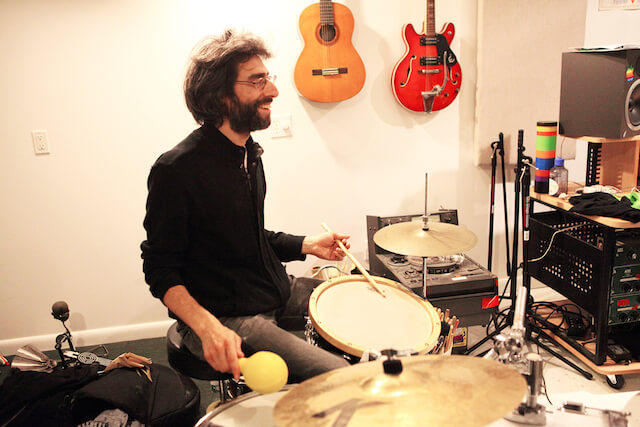

11:19 am
“So, how do we start this thing?” Stitelman asked the room. Chas had a couple of ideas. “We have really awesome instrumentation,” he said. “A vague idea I had was to work with maximizing a small amount of content, so if anyone has an idea, throw it out, and we can build off of it.” The group nods. “Maybe we can start jamming on something on the low end of the band,” Refosco said, pointing to Kent and the cello.
Kent and Refosco, on a drum, begin working out a beat, simple repetitive framework that the other musicians begin joining in on. Chase jumps in quickly to strengthen the slowly forming pattern. Yasutake picks up his trumpet and adds a long, swooping crescendo. Stitelman, on guitar, finds a chord and sings, and first haltingly and then with greater ease, a looping series of “ooos.”If you’ve ever sat through a jam session, you know this scene, more or less. From the cluttered jamming stream, certain elements begin to emerge; you pluck them out, build on them, polish them. There are some fits and starts; Stitelman jokes that he doesn’t quite have a grasp on scales. “As a jazz school graduate, scales are overrated,” Yasutake assures him. “It’s about the notes that I don’t know,” Stitelman replies. “That’s a pretty Sun Ra thing to say,” Yasutake replies.
12:31 pm
The jamming and refining has produced a loose, meditative number, one that has hints of Radiohead or, as Stitelman points out, the band Morphine. “So that’s our first song,” he announces. One down, at least two more to go, less than eight hours until the band has to load back in to Baby’s All Right. And then there’s the matter of the band name, which every group has to come up with. “What about Fuck Vice?” Stitelman offered. Refosco brings out a volume of Karl Ove Knausgaard’s “My Struggle” and starts leafing through passages. “What about ‘admiration of tadpoles’?” he asked. Time for a coffee break.
2:13 pm
In the time I took to go get coffee and type up my notes, another song is beginning to take shape. Some of the musicians gathered back at Baby’s All Right for lunch, but given the distance and the rain, Chase’s assembly has stayed put. The new song one is shorter, sharper, a little more punk inspired. “I assumed that I was going to be in a group of guitarists and start a punk band,” Stitelman observed. Kent wonders if there is crazy glue to apply to the blisters on her hand developing from cello playing. “You can use it just like Nu-Skin,” she said. “That is punk rock,” Stitelman said. From his wall of percussion wonders, Refosco has brought out a balafon, a kind of wooden xylophone with resonators made of gourds; the number requires a “noise part” with the musicians jamming out on a certain section. They record the new installment on Refosco’s computer, to refer to later. “That’s the Death Star song, man,” Yasutake said.
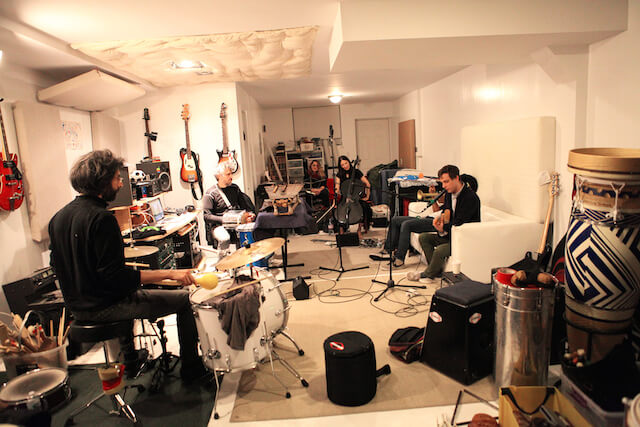

5:21 pm
The band, now officially known as Friend of a Friend, has finished up the last of the three original songs. (The third song is the only one with a title: “Sex and Laundry.”) Refosco has added a set of bongos and maracas to his set-up, and the atmosphere is one of mixed accomplishment and exhaustion. And there’s a matter of doing a cover song, if they want to. At this point, a cover is just a cherry on top: They’ve gotten to three original songs, so the set is mostly done, but there’s something appealing about that extra effort. The members began throwing out ideas. “I don’t know if you guys are familiar with the Dave Matthews Band?” Stitelman asked. Here is where the lack of bass becomes a problem: A lot of cover songs are reliant on that particular instrument.
The crew went through a rendition of Roy Orbison’s “Only the Lonely” and the Ritchie Valens song “Oh Donna” before hitting on the Ronettes classic “Be My Baby.” The whole thing began to click when Refosco brings out a cuica drum, which adds a pleasing bit of silliness to the endeavor, the high-pitched squeak punctuating the familiar tune.
7:01 pm
“Shall we run this on more time?” Chase asked. The whole set is in place; the band rehearses it once through the whole way through. It’s been a grueling day already, and there’s still at least another three hours until the first group takes the stage. But there’s something amazing about producing all of this in a day, and it’s such an ephemeral product. After they finished running through the whole set, Stitelman, who has morphed into the frontman over the course of the day, paused: “None of these songs will ever be played again.”
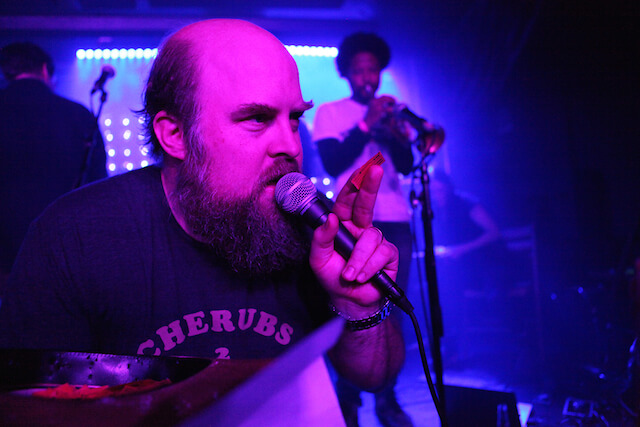

10: 17 pm
Les Savy Fav’s Tim Harrington takes the stage to introduce the first band at Baby’s All Right, putting forth a kind of infectious, manic energy that will propel the rest of the night forward. Chase’s group is the last one scheduled for the evening. Before, the results of all the other groupings is on display: A scuzzed up, banjo-infected indie pop set by the best named band of the night, Fraud Stewart, and the straight-ahead rock stylings of TBOI, which includes Travis Morrison and Jess Kristin. The all-bassist’s band’s set is one of the most memorable: Rather than having one member switch out instruments, they leaned in, so to speak, to create a pounding set somewhere one the metal-hardcore spectrum, including a cover of the Spinal Tap song “Big Bottom.” Most of the other groups have stuck to two original songs and one cover version, I note, somewhat smugly. Results are, as you might imagine, mixed, but many of the songs that debut are impressively good, even if you didn’t account for the timeframe and circumstances.
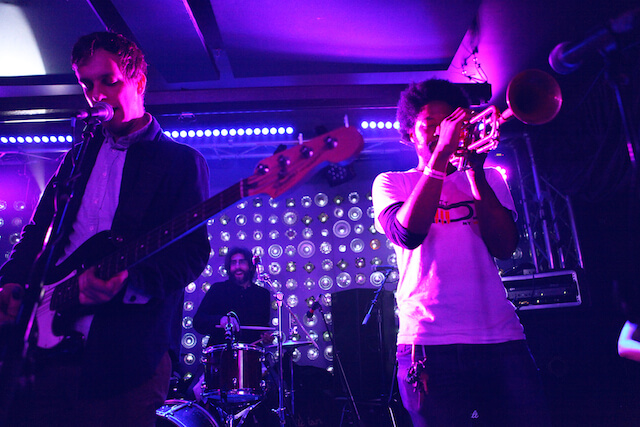

12:13 am
Twelve hours after being grouped into their band-for-the day, Friend of a Friend took the stage. Though the day has been long, there was not a single member of the group who isn’t smiling when they’re setting up; the energy of the whole endeavor, and the challenge of it, is invigorating. Even Chase, who has a tendency to look serious on stage, was obviously having fun. At various points in the set, he was just grinning from ear to ear. And the set sounded really good: a little loopy, a little quirky, a little funk-inspired. I would go see them again, if they ever played. Except they won’t: The Lottery is about making this moment, not a recording, not a group that’ll continue on through the ages.
When the group finished the last bars of “Be My Baby,” they were met with applause from the audience. Harrington took the stage to announce the raffle ticket winners. Stitelman high fived me from the stage, grinning. “We did it!” he yelped. I left with the songs echoing in my head, tired but pleased, determined to come back to the Lottery next year.
You might also like 














